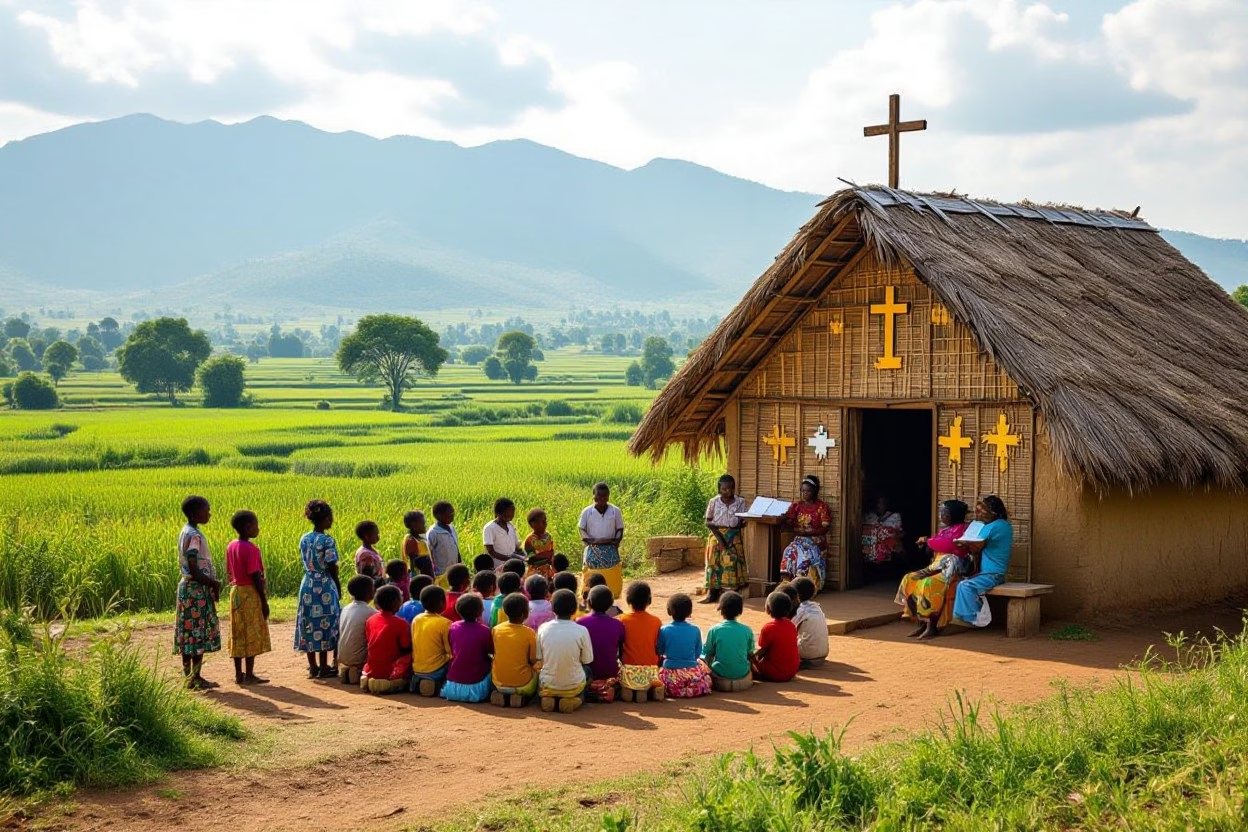You may wonder why Christianity is expanding rapidly across Africa and Asia, becoming the new center of global faith. This growth is driven by high birth rates, vibrant local leadership, and dynamic evangelism that adapts to diverse cultures. Despite facing persecution and social challenges, communities find hope, empowerment, and social support through the church. As urbanization and education rise, Christianity continues to resonate deeply with your generation, transforming societies and reshaping the religious landscape worldwide.
Key Takeaways:
- High birth rates in Africa, combined with a young and rapidly expanding population, significantly contribute to the natural increase of Christians on the continent, while Asia experiences growth through a mix of birth rates and conversions.
- Dynamic grassroots evangelism and the rise of indigenous churches make Christianity more accessible and culturally relevant in both Africa and Asia, fueling expansion.
- Charismatic and Pentecostal movements play a powerful role, especially in Africa, attracting new believers through vibrant worship and focus on personal transformation.
- Strong family and community networks in African societies support communal faith growth, while churches often deliver important social services like education and healthcare, strengthening their societal influence.
- Christianity’s message of hope, compassion, and empowerment resonates deeply with populations facing economic, political, and social challenges in these regions.
- Urbanization and increasing education levels help Christianity gain traction among young professionals and the middle class, particularly in Asia’s rapidly developing cities.
- Despite persecution and legal restrictions, especially in parts of Asia, Christianity demonstrates resilience through underground churches and grassroots movements, contributing to its steady growth.

The Fertile Ground: Demographics Driving Growth
Youthful Populations and High Birth Rates
The youthful demographic profile of Africa stands out as a powerhouse for Christian growth. With one of the highest fertility rates globally, many African nations boast median ages well below 20, fueling a natural increase in the number of Christians almost by default. By 2050, projections estimate Africa will host over a billion Christians, marking a substantial fraction of the global Christian community. This demographic momentum means that the spreading faith isn’t merely a result of conversion efforts but is significantly amplified through family growth, where children are born into Christian households and communities continue expanding organically.
Asia, while having more varied birth rates, still contributes meaningfully to Christian population growth through regions with higher fertility combined with burgeoning youth populations. In countries like India and Indonesia, younger generations are increasingly engaging with Christianity, often influenced by local churches that resonate culturally. Although birth rates in Asia don’t match Africa’s intensity, the large population base means even modest growth translates into millions of new believers, pushing the Christian population past 380 million in some estimates. This blend of youthful populations and steady fertility rates sets a demographic bedrock for Christianity’s ongoing rise in both continents.
Migration Patterns and Urbanization Trends
Internal and cross-border migration plays a subtle but important role in the reshaping of Christianity’s demographic landscape. As rural populations move into cities in search of better opportunities, they bring their religious practices and affiliations with them, creating dynamic urban congregations. Cities across Africa and Asia witness an influx of young migrants who find in Christianity a familiar and supportive community amid rapid social change. Urban centers in countries such as Nigeria, Kenya, India, and the Philippines have seen churches grow rapidly, fueled by this migration-driven congregation expansion.
Urbanization itself drives Christianity’s traction by exposing individuals to diverse belief systems while providing fertile soil for churches that address modern social and economic challenges. The rise of middle-class, educated youth in urban areas aligns closely with Christianity’s message of hope and empowerment, allowing it to take root in settings characterized by fast-paced lifestyle changes and growing social complexity. This transformation is especially visible in Asian metropolises like Seoul, Jakarta, and Mumbai, where churches actively engage with youth culture and contemporary issues.
Mass migration toward urban hubs creates concentrated communities where churches can serve as pivotal social networks offering education, healthcare, and spiritual support. Beyond mere population shifts, this urban concentration enables churches to innovate worship styles, social outreach, and evangelism methods, closely aligning faith practice with the realities of urban life. As a result, Christianity’s embeddedness in city life strengthens its appeal among younger, upwardly mobile populations who shape the religious landscape of tomorrow.
The Power of Local Movements: Evangelism Reimagined
Grassroots Movements and Indigenous Leadership
Indigenous leadership has become a cornerstone of Christianity’s expansion throughout Africa and Asia. You’ll find that local pastors and community leaders, deeply rooted in their cultural context, are uniquely positioned to communicate the Gospel in ways that resonate authentically with their communities. This approach has fostered a strong sense of ownership among believers and given rise to vibrant indigenous churches that reflect local languages, traditions, and social realities. In Africa, for example, churches led by African clergy have experienced rapid growth by integrating worship styles, music, and communal practices that connect powerfully with congregants’ daily lives.
In Asia, the rise of indigenous churches is similarly transforming Christian witness. Countries like India, Indonesia, and China boast grassroots evangelists who navigate complex social and political landscapes to nurture their flocks. This local leadership proves indispensable, especially under pressure from legal restrictions or societal hostility. Your support for these indigenous initiatives enables Christianity not only to survive but to thrive by fostering authentic spiritual communities that emphasize personal transformation and communal solidarity.
Charismatic and Pentecostal Influence
The dynamic energy of Charismatic and Pentecostal movements plays a major role in attracting millions across Africa and Asia. Their worship services, characterized by exuberant praise, healing ministries, and moments of spiritual empowerment, offer you an immersive, transformative faith experience. In many African countries, Pentecostal churches are among the fastest growing, drawing individuals hungry for hope and tangible encounters with God. This movement’s emphasis on personal renewal, miracles, and deliverance addresses real-life needs in contexts marked by poverty, illness, and social instability, making faith immediate and relevant.
Asia’s burgeoning Pentecostal landscape reveals a similar pattern, particularly in urban centers where young professionals seek both community and spiritual vitality. Despite facing persecution or government restrictions, Pentecostal networks continue to expand through underground churches and vibrant house gatherings in nations like China and Indonesia. Their success hinges on offering believers a sense of empowerment and agency amid challenging environments, fueling growth that defies adversity.
Charismatic and Pentecostal movements emphasize a lived experience of the Holy Spirit that goes beyond traditional liturgies, focusing intensely on the present-day power of God to heal, transform, and empower. This approach resonates deeply with people confronting poverty, illness, and social upheaval, creating a faith that is not just theological, but practical and deeply experiential. Their growth reflects adaptability—meeting people where they are with messages of hope, healing, and divine intervention that carry tangible impact in daily life across both continents.
Community as Catalyst: The Role of Social Support
Churches as Community Hubs
You’ll find that churches in both Africa and Asia serve as much more than places of worship—they act as vital community centers where social life revolves around shared faith. In many African societies, the church is deeply embedded within family and communal networks, enabling religious gatherings to double as social events. This communal nature encourages collective participation and fosters a strong sense of belonging, which in turn accelerates the spread of Christianity through word-of-mouth and communal activities. These hubs also provide a safe space for people to find emotional and spiritual support, especially in regions where socio-economic challenges are widespread.
In Asia, the growth of indigenous churches has similarly transformed them into hubs of community life. Urban churches, particularly, have become centers where young professionals and students gather not only for worship but also to network and discuss social issues. These churches often host cultural events, language classes, and youth programs that adapt Christianity to local customs and modern urban demands, making the faith more relevant and approachable. The dynamic, community-centered approach makes churches natural catalysts for faith expansion as they meet both spiritual and social needs simultaneously.
Educational and Health Services Provided by Churches
Churches in Africa and Asia have long provided imperative educational and health services, significantly strengthening their influence within communities. Thousands of church-run schools across sub-Saharan Africa serve millions of children annually, often filling gaps left by underfunded public education systems. For example, Catholic and Pentecostal networks operate schools that emphasize not only literacy but also moral and character education, creating enduring bonds between families and the church. In Asia, churches have expanded similar educational outreach, particularly in countries like India and Indonesia, where church schools provide affordable, quality education to underserved populations.
Beyond education, health services offered by churches contribute tangibly to their growing social role. Clinics and hospitals affiliated with Christian organizations deliver imperative healthcare in remote and impoverished areas, sometimes being the only reliable medical resource available. Programs focused on HIV/AIDS awareness and treatment, maternal health, and child nutrition have not only improved community well-being but have also enhanced the church’s reputation as a caring and indispensable institution. Your awareness of this comprehensive social support highlights why Christianity often grows hand-in-hand with the societal development these churches promote.
One standout example is the impact of faith-based healthcare in rural African regions, where church-operated clinics provide vaccinations and maternal care, reaching populations often neglected by government agencies. Similarly, in parts of Asia facing legal restrictions or persecution, underground house churches often pair spiritual ministry with discreet social services, quietly strengthening community resilience. These tangible benefits create positive associations with Christianity, fostering higher retention rates and encouraging conversions despite broader social or political obstacles.
Cultural Resonance: Spiritual and Social Appeal
Christianity’s Message of Hope and Empowerment
Across Africa and Asia, Christianity taps into a profound yearning for hope, compassion, and personal transformation amid widespread social and economic challenges. You see communities grappling with poverty, political instability, and rapid modernization, where traditional structures often feel overwhelmed or fractured. Christianity’s teachings offer not only spiritual solace but also an empowering vision that uplifts individuals and families, promising dignity and a future beyond current hardships. This message resonates especially through charismatic and Pentecostal movements, which emphasize healing, renewal, and a tangible experience of the divine, drawing millions into vibrant worship and renewed faith.
In urban centers and rural areas alike, you’ll find Christianity providing a framework for meaningful change, encouraging adherents to embrace resilience and agency. The faith’s emphasis on love and community makes it more than a private belief system—it becomes a source of practical support and moral encouragement. For many, this sense of belonging and hope transforms lives amidst uncertainty, contributing to dynamic church growth seen across countries like Nigeria, South Korea, and Indonesia.
Appeal Among Marginalized Populations
Christianity’s growth in marginalized populations across Africa and Asia stems from more than doctrine; it addresses tangible needs for inclusion and justice. The faith’s teachings foreground equality and care for the downtrodden, reaching people historically excluded from social and economic power. Dalits in India, rural villagers in sub-Saharan Africa, and ethnic minorities in Indonesia often find in Christianity a community that acknowledges their worth and advocates for their rights, offering both spiritual dignity and social uplift.
This social embrace manifests through church-led initiatives in education, healthcare, and social welfare, which help bridge gaps left by state institutions. You encounter a faith movement that actively counters marginalization by creating spaces where empowerment is practiced daily. In contexts where caste, ethnicity, or economic class have dictated one’s status, Christianity’s inclusive message bolsters identity and hope, fueling its rapid expansion among these groups.
Further strengthening this appeal is Christianity’s adaptability to local cultures, languages, and struggles, making its message relatable rather than foreign. By incorporating indigenous leadership and contextual worship styles, churches foster a sense of ownership and pride among marginalized believers. Additionally, despite persecution in some regions, these communities often demonstrate remarkable resilience, deepening their commitment and drawing others into a faith that insists on human dignity and collective upliftment.

Resilience in Adversity: Growing Amidst Persecution
The Underground Church Phenomenon
In countries like China, India, and Indonesia, you witness Christianity flourishing despite stringent government restrictions and societal opposition. Many believers gather in underground house churches, which operate covertly to avoid detection by authorities. These small, intimate congregations enable Christians to worship, study scripture, and support one another without drawing unwanted attention, demonstrating a remarkable ability to sustain faith under pressure. For instance, in China alone, estimates suggest tens of millions attend these unofficial gatherings, a number that has only grown over the past decades despite intensified crackdowns.
Such clandestine communities often foster deep bonds of trust and solidarity, which strengthen the spiritual resilience of their members. The underground church model prioritizes adaptability—meetings may change location frequently, rely on encrypted communication, and emphasize discipleship in daily life. This resilience is not limited to survival but fuels expansion, as converts are drawn by the tangible commitment and sense of purpose exhibited by believers who risk persecution for their faith.
Cultural Adaptations and Community Strength
Christianity’s growth in Asia and Africa also rests heavily on its ability to embed itself within local customs and social networks. Rather than imposing foreign traditions, many indigenous churches incorporate native languages, music styles, and cultural expressions into worship, creating a faith experience that feels both authentic and relevant. You can see this across Pentecostal and charismatic movements, where worship blends vibrant local rhythms with spiritual fervor, attracting especially young people and families.
Community structures play a powerful role as well. In African societies, for instance, the church often functions as an extended family, where mutual support and collective worship encourage new adherents to join and stay. The communal nature of faith means conversion often happens in social clusters rather than isolated individuals. Churches also serve as centers providing education, healthcare, and practical assistance, making them indispensable pillars within their communities. This integration within everyday life creates a social safety net that encourages steady growth even in difficult circumstances.
Beyond worship practices, local church leaders are frequently drawn from the community itself, which deepens trust and relevance. When your pastor shares your language, customs, and daily challenges, the message of Christianity resonates more profoundly. This grassroots leadership has proven crucial in sustaining faith under persecution and rapid social change, ensuring that the gospel not only survives but thrives by reflecting the lived realities of its congregants.

Urbanization Unleashed: Christianity in Modern Cities
Rise of the Middle Class and Young Professionals
Younger generations in African and Asian cities are increasingly finding Christianity aligning with their aspirations and lifestyles. As urban centers expand, the burgeoning middle class—comprised largely of young professionals—seeks communities that provide both spiritual guidance and practical support in navigating fast-paced city life. In places like Lagos, Nairobi, Seoul, and Manila, you’ll notice vibrant urban churches offering relevant programs tailored to professionals, ranging from career mentoring to business networking and community service.
The appeal of Christianity among this demographic also lies in its ability to foster identity and purpose amid rapid social change. You witness middle-class believers embracing faith groups that emphasize personal development alongside communal worship, blending modernity with tradition. This balance attracts those striving for upward mobility, as churches often serve as hubs for social capital, offering connections and a sense of belonging. Estimates suggest that urban Christian populations in Asia alone could reach over 300 million by 2030, underscoring the faith’s resonance with city dwellers.[4][9]
Addressing Contemporary Issues Through Faith
Christian institutions in urban Africa and Asia have adapted their messages to engage directly with modern challenges such as unemployment, inequality, and mental health. Faith leaders speak openly about these issues, presenting Christianity as a source of empowerment and practical hope. Urban churches often run workshops on financial literacy, leadership skills, and even entrepreneurship, helping you to see faith as a tool for overcoming economic hardships rather than a distant spiritual ideal.
In rapidly developing cities, where social fragmentation can leave many isolated, churches provide spaces for connection, healing, and advocacy. For example, Pentecostal and charismatic movements popular in these regions emphasize personal transformation, offering emotional and psychological support alongside spiritual renewal.[3][7] This holistic approach addresses both your everyday struggles and deeper existential questions, making Christianity highly relevant in the urban context.
Such churches also engage actively with contemporary debates on ethics, justice, and social responsibility. Their growing use of media and technology amplifies messages that challenge corruption, promote gender equality, and encourage youth participation in civic life. This responsiveness to pressing societal concerns strengthens your trust in Christianity as a dynamic force addressing not only spiritual needs but also contributing meaningfully to the shape of modern cities.
Global Dynamics: The Shift in Christianity’s Center of Gravity
The Transition from the Global North to South
The landscape of global Christianity has undergone a profound transformation over the last century. What was once predominantly centered in Europe and North America now finds its vibrant epicenter in Africa, Asia, and Latin America. Sub-Saharan Africa, in particular, has witnessed explosive growth fueled by high birth rates and dynamic indigenous leadership, pushing it toward becoming the largest concentration of Christians worldwide. By 2060, projections indicate that 40% of the world’s Christians will reside in sub-Saharan Africa alone, eclipsing traditional strongholds in the West.
Asia mirrors this shift with a growing Christian population exceeding 380 million, spread across countries like China, India, Indonesia, and South Korea. You can see how grassroots evangelism combined with the resilience of underground house churches amidst persistent persecution has allowed Christianity to deepen roots across the continent. This transition highlights a move away from Christianity as a faith associated with Western cultures toward a truly global and multicultural religion, shaped increasingly by African and Asian believers themselves.
Projections for Future Growth and Influence
Looking ahead, Christianity’s growth trajectory in Africa and Asia is set to outpace other regions dramatically. Africa’s youthful demographic offers a powerful engine for natural growth, with families expanding and new generations embracing the faith within culturally resonant contexts. The rise of Pentecostal and Charismatic movements is amplifying this surge, as these energetic and community-focused expressions of Christianity appeal strongly to the continent’s diverse populations. By 2050, you can expect Africa to be home to over one billion Christians, a number that redefines global religious demographics and influence.
In Asia, the interplay of urbanization, education, and social upheaval creates fertile ground for Christianity’s continued expansion, even in places where it faces legal challenges and persecution. The resilience of believers and their capacity to adapt church models to local traditions ensures Christianity’s presence will deepen. As middle classes grow and more young professionals find resonance in the faith’s message, Christianity’s influence within Asian societies is likely to expand into cultural and social arenas far beyond worship, shaping the region’s future.
These projections show that Christianity’s future influence will be defined by its demographic vitality, cultural adaptability, and persistent social relevance in the global South. You’ll see the global Christian community become increasingly diverse and decentralized, with Africa and Asia not only driving numerical growth but also setting new theological, liturgical, and missional trends worldwide. This reshaping challenges you to reconsider Christianity’s global identity, as well as the leadership and voices that will shape its next century.
Conclusion
Upon reflecting on why Christianity is growing fastest in Africa and Asia today, you can see that multiple interwoven factors are at play. Your understanding of the demographic momentum, where high birth rates and youthful populations fuel natural growth, helps illuminate one of the foundational drivers. Additionally, the influence of dynamic evangelism, indigenous leadership, and charismatic movements highlights how the faith is not simply spreading through numbers but through culturally adapted and locally led expressions that resonate deeply with communities. This adaptability, combined with strong family and social networks, allows Christianity to flourish in ways that are meaningful and enduring for many people in these regions.
As you consider the social and spiritual appeal Christianity offers, especially amid rapid urbanization, educational advances, and societal challenges, you realize how the faith meets the needs for hope, purpose, and community. Your awareness of the resilience Christianity shows despite persecution in some areas further underscores the dedication of believers and the faith’s capacity to thrive under pressure. Together, these elements explain why the center of global Christianity has decisively shifted to Africa and Asia, reflecting a transformation that shapes the present and future of the religion worldwide.
FAQ
Q1: Why is Christianity experiencing rapid growth in Africa compared to other continents?
A1: Christianity’s rapid growth in Africa is largely driven by high birth rates and a youthful population, which naturally increases the number of Christians through family expansion. Additionally, strong community and family structures, dynamic grassroots evangelism, and the widespread influence of charismatic and Pentecostal movements further accelerate this growth. Churches also play a significant role by providing education, healthcare, and social support, strengthening their impact in society.
Q2: How does the growth of Christianity in Asia differ from that in Africa?
A2: While demographic momentum through high birth rates is a primary driver in Africa, growth in Asia relies more on dynamic evangelism, urbanization, education, and resilience amid persecution. Growth is notable in countries like China, India, South Korea, and Indonesia, where underground churches and grassroots movements thrive despite legal and social restrictions. Urban middle classes and young professionals are increasingly drawn to Christianity as well.
Q3: What role do indigenous churches and local leadership play in the spread of Christianity in these regions?
A3: Indigenous churches and local leadership are vital to Christianity’s expansion in both Africa and Asia. By adapting Christian teachings to local languages, traditions, and cultures, these leaders make the faith more relatable and accessible. They spearhead grassroots evangelism efforts, ensuring that Christianity resonates with the cultural context of diverse communities, which enhances its appeal and sustainability.
Q4: Why are charismatic and Pentecostal movements particularly influential in Africa and parts of Asia?
A4: Charismatic and Pentecostal movements attract many new believers through their energetic worship styles, emphasis on personal transformation, healing ministries, and experiential faith practices. These movements often address the spiritual and social needs of communities, offering hope and empowerment in contexts marked by economic challenges or social instability, making them especially appealing in Africa and certain Asian countries.
Q5: How do social services provided by churches contribute to the growth of Christianity in Africa and Asia?
A5: Churches often provide imperative services such as education, healthcare, and social support, which improve the quality of life in their communities. This provision of social goods increases the churches’ standing and trust among local populations, creating an environment where faith can spread more effectively. Social support networks linked to churches also reinforce communal bonds and collective religious participation.
Q6: In what ways does Christianity address social and economic challenges faced by populations in Africa and Asia?
A6: Christianity offers messages of hope, compassion, dignity, and empowerment that resonate deeply with populations experiencing poverty, inequality, or political instability. By promoting care for the marginalized and emphasizing community support, Christianity provides both spiritual guidance and practical assistance, encouraging people to find stability, purpose, and solidarity in turbulent times.
Q7: How does persecution affect the growth of Christianity, especially in Asian countries?
A7: Despite persecution and legal restrictions in several Asian countries, Christianity continues to grow due to the resilience and adaptability of believers. Underground house churches and grassroots movements operate discreetly, fostering strong, committed communities. Persecution often strengthens faith among members, leading to increased determination to sustain and expand Christian presence.


Leave a Reply